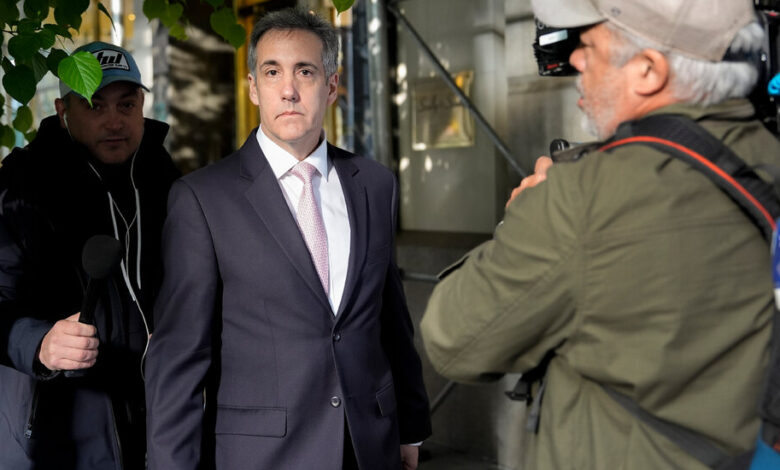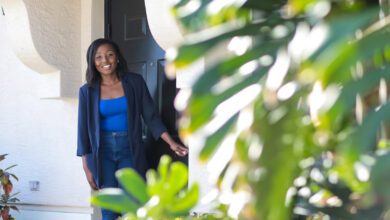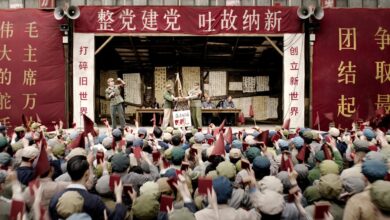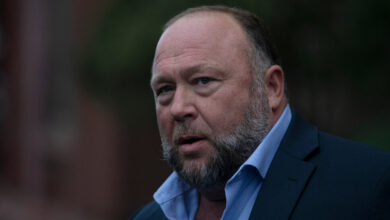The Trump Trial on Cable TV: Play-by-Play and Drawings on an iPad

The trial of former President Donald J. Trump has all the elements of a made-for-TV thriller: sex, politics and potential consequences for the future of the republic.
One problem: no TV.
Cameras and audio recording devices have been banned from the Lower Manhattan courtroom that is hosting the first-ever criminal proceeding against a former president, creating something of a headache for the cable news anchors and producers assigned with covering a monumental event in American life via a decidedly visual and aural medium.
The testimony on Monday of Michael Cohen, Mr. Trump’s lawyer-turned-witness for the prosecution, was the kind of highly anticipated, high-drama moment that would make for riveting television if it could be watched live. Instead, anyone following along on TV was treated to a rolling graphic of text-based updates — essentially an on-air blog, with running updates based on real-time feeds sent by a reporter sitting in the courtroom — as anchors and legal experts pontificated on proceedings they could not see or hear.
Sketches, still photographs and footage of Mr. Trump walking in and out of the courthouse now typically fill the screens of the major cable news channels, as their on-air personnel narrate the day’s events. The coverage has the feel of a live baseball radio broadcast, with commentators creating word-pictures for their audience.
“We’ve been told that Donald Trump, as is his wont, is looking straight ahead in his seat, not to the right, where Michael Cohen is the witness,” the anchor Jake Tapper told CNN viewers on Monday morning after Mr. Cohen took the stand. “Cohen leans to his right, then stands up and identifies Trump in court.” He added later that Mr. Trump’s “eyes appeared closed, as Cohen is identifying him.”
Last week, Mr. Tapper, who has been among the lead faces of CNN’s trial coverage, decided that if he couldn’t share live images of the courtroom with his viewers, he would go for the next best thing.
Mr. Tapper, a semiprofessional cartoonist who once wrote a comic strip for the Washington newspaper Roll Call, opened a drawing app on his iPad and drew his own courtroom sketches. “Art is interpretive, obviously,” he told viewers, before presenting his images of Mr. Trump, Stormy Daniels, Justice Juan M. Merchan and other key figures. (Mr. Tapper also called out the talents of the regular courtroom artists covering the trial, including Jane Rosenberg and Christine Cornell.)
“We have to seize any opportunity to bring this story to life, taking viewers and listeners into this closed courtroom with the resources at our disposal,” Mr. Tapper wrote in an email message on Monday. “Whatever we can do to bring this to life for audiences will make a difference in how they understand the history playing out.”
TV journalists do have a few helpful tools at their disposal.
Justice Merchan agreed that journalists who snagged seats inside the courtroom could transmit updates from their laptops, allowing for instantaneous updates. (In the courtroom, the sound of fingers clicking on keyboards tends to increase during big moments of testimony.)
In some previous high-profile trials with no cameras, such as the Martha Stewart case in 2004, journalists resorted to other methods, like sprinting out of the courtroom to make phone calls to relay details to editors and producers.
Transcripts of the Trump trial are also released on a relatively expedited basis, shortly after the end of the day’s proceedings, which has allowed legal experts to review testimony in full ahead of their appearances on prime-time cable shows.
One of those experts is Jeffrey Toobin, the veteran legal journalist who helped pioneer television court reporting during the O.J. Simpson murder trial in 1995, a fully televised spectacle that gripped the nation for weeks. In an interview, Mr. Toobin, who is analyzing the Trump trial for CNN, said that the lack of cameras had distinctly changed how this trial had been perceived and absorbed in the culture.
“If there were cameras in the courtroom, it would be O.J.-level,” Mr. Toobin said. “The faceoffs between Cohen and Trump, and Stormy and Trump, would have been the defining television images of the year, if not the decade. Those pictures just don’t exist.”
Mr. Trump’s trial has still garnered a lot of attention, Mr. Toobin said, and he acknowledged that “the stakes for the future of the republic are higher here than they were with O.J.” But he said he did not expect the relatively obscure figures of this Trump case, like the judge and the lead lawyers, to achieve the same level of fame as their counterparts in the Simpson trial, like Lance Ito and Johnnie Cochran.
“The lawyers become a lot less famous this way,” Mr. Toobin joked.



